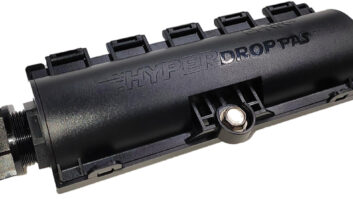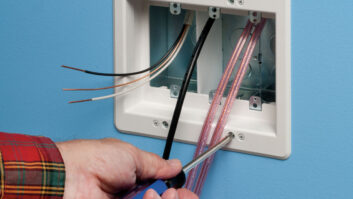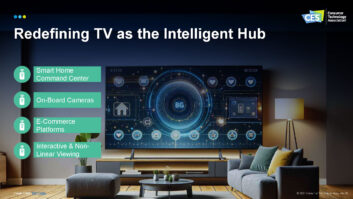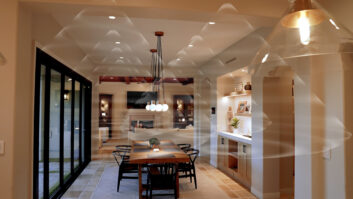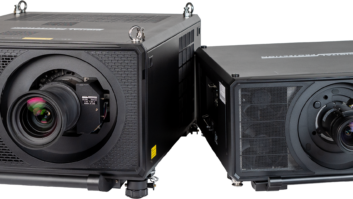In taking our annual look at Comdex and the Western Cable Show, it is important to look beyond the difficult challenges facing the technology business and to identify relevant new products and concepts for the residential installation marketplace. Among the uncertainty tied to troubling economic times and a war on terrorism, there may also be some new business opportunities on the horizon for residential systems professionals.
Once the king of all domestic trade shows, Comdex appeared to be dealt a major blow by world events. By any measure, the show lost both attendees and exhibitors. It clearly didn’t help that this was one of the first major shows after the New York and Washington attacks, and zealous security regulations didn’t improve Comdex’s image as a show that has always been difficult to navigate for one reason or another. Remember that Comdex has always been an “enterprise” show, with business computing hardware and software as the main focus. The business downturn underway before 9/11, and more specifically, the collapse of the “dot-com” world, were directly responsible for the show’s contraction into one Las Vegas venue, the reduced exhibitors showings and the 35 percent drop in attendee count from past years. Despite the fact that “enterprise” and “B2B” worlds appear to be shrinking, there were some products and concepts that could provide interesting applications on the residential side. Perhaps the most interesting clue in this regard occurred during a keynote speech from Microsoft’s Bill Gates. While Gates’ audience appeared only mildly interested in all of the new enterprise-related products displayed, the house went wild during a detailed Xbox demonstration at the end of the speech. Cynics might say that the give-away of a few consoles helped the applause, but the realistic game play and Internet-enabled, hard-drive-equipped console proved that computing and networking in the home now have a firm reason to move beyond simply linking computers, printers and broadband modems. Who will enable and support the residential infrastructure needed to bring broadband to the Xbox in “junior’s room?” Xbox will be one of the forces that continue to feed the demand for distributed in-home broadband services.
Not to be outdone, the opening-day keynote by Sony’s president and COO, Kunitake Ando, not only gave additional emphasis to themes raised at other Sony presentations last year, it provided us all with more reasons to emphasize the benefits of broadband and home networking. Known as the “father of the Vaio,” Ando re-emphasized Sony’s pledge to support Internet Protocol Version 6 (IPv6) that will create an expanded pool of IP addresses so that every Sony product will eventually be able to include an IP address. As a hint to readers who eschew wireless technologies, many of the prototype products that were demonstrated used 802.11a technology for wider bandwidth and less competition with other products than is found in the current 802.11b wireless band. If your company’s skill set is limited to pulling wires, the message here is that you had better learn about wireless technology installation and configuration techniques.
As if to emphasize the importance of wireless, Sony not only has pooled their cell phone handset business in a joint venture with Ericsson, they have agreed to collaborate with a number of firms, including Nokia on a protocol for interoperability of wireless devices. Further evidence of Sony’s embrace of the broadband world was the announcement of an agreement to work with AOL/Time Warner on what was called “…an open broadband network for the delivery of consumer entertainment…” that will enable Sony and its partners to create what AOL’s Steve Case called “…the movement of the digital house hold from dream to reality.”
As one might expect, among the prototype products in the demonstrations during the keynote were applications of Sony developed or supported technologies such as Memory Stick and the first demonstration we have seen of a PlayStation2 used for the transmission of HDTV content. However, Sony executives would not comment on when any practical HD applications for PSX2 would be available in the marketplace. Indeed, as of late December we still have no firm delivery date for the hard drive and Ethernet adapters promised for PSX2 back in May at E3.
Two Sony products, one shown in production form and one in prototype form, signal other things at work from Sony. The former was Sony’s first single-chip DLP projector. While intended for the “road warrior” market, the DLP model is a major change from Sony’s long-held adherence to LCD as the proper technology for fixed array projectors. It’s doubtful that there will be more DLP models for the home market, but this does show that the LCD dam has been breached. The latter product was a “home server” with a full terabyte of data storage capacity. While some might say that Sony (and, for that matter, Microsoft) plan to make the game console the ultimate home server, this prototype indicated otherwise. Add to that that the commitment to wireless and you get both a reason and a method for home networking.
Indeed, despite the enterprise focus of Comdex, some interesting networking products with distinct residential applications were on display with 802.11b (WiFi) the most pervasive technology shown. Prices are dropping to the point where wireless will undoubtedly become a major factor in the home network arena this year. All the major players such as Netgear, Linksys, SMC and D-Link now offer cable/DSL routers with built-in 802.11b capability, with other first and second tier brands soon to jump on that bandwagon. The high-volume production of 802.11b products for the enterprise world has driven their cost down to the point where 802.11b is a viable choice for the home, a concept that was validated on a number of fronts two weeks after Comdex at the Western Cable Show. HomeRF is still in the race despite the loss of major proponent Intel earlier this year and it now offers over 10 MB/s throughput to match 802.11b. However, it remains to be seen if HomeRF can avoid being flattened by the WiFi steamroller.
As a strictly consumer product, HomePNA was not very visible as a networking topology at Comdex. There were no major new PNA products, though it continued to be among the topology offerings in some manufacturers’ lines. Power line based products, however, were in evidence, particularly from Netgear, where a totally new line of consumer-centric products was unveiled, including PLC bridges with 14 MB/s capability. One area where these PLC products are key is for use with consumer “appliances” such as Internet radios and Internet-driven HDD jukebox products, where RJ-45 connectivity is used in place of the USB connectivity typical in the computer world for PNA and 802.11b.
Elsewhere in networking and connectivity, Bluetooth continues to attempt to seek widespread adoption at the lower data-rate side of the market. At this year’s Comdex Bluetooth held its place as a short-range connection possibility but did not markedly expand it. At the high data-rate side of the market Comdex saw a number of companies such as Proxim and SMC showing 802.11a products that take advantage of the “a” format’s 5 GHz frequency band to eliminate the interference from products such as cordless phones and microwaves that plague users in the 2.4 GHz band.
As a side note, however, just as Comdex closed, a formal acceptance agreement for the 802.11g format was announced. Operating in the 2.4 GHz band it is subject to the same interference problems as 802.11b and Bluetooth, but it offers up to 24 MB/s capability and unlike 802.11a it is backwards compatible with existing 802.11b “Wi-Fi” infrastructure.
Comdex also served as a landing point for one of the more closely watched format battles that will have significant impact on the consumer electronics industry. At overlapping press conferences the DVD-RW and DVD+RW camps both presented their case. Announcing the formal introduction of the Recordable DVD Council, or RDVDC, the DVD-RAM and DVD-RW camps joined together to provide marketplace support for the two recordable formats approved by the DVD Forum.
Indeed, that approval was a constant message in the presentation that also emphasized the 2x capability of the RAM discs so that machines such as those now featured at retail from Panasonic may offer the “TimeSlip” feature that turns a DVD-RAM into a virtual PVR.
Lack of Forum approval seemed not to worry the proponents of the rival +RW format, who pointed to what they claim is the “high level of sharability” of their format in the form of higher compatibility with existing DVD players. “Plus” drives are now available for use with computers and Philips is selling a consumer +RW deck. We expect to hear more from Thomson for their +RW plans at CES and Sony, the other main +RW proponent for the consumer electronics world is still mum on their previously announced plans for a dual-format -RW/+RW unit. We’ll have word on that in this space after the January show. For the moment however, all three recordable DVD formats are still at an early market stage with relatively expensive decks and discs. This is definitely one to watch on a number of fronts for 2002.
Comdex often provides some new product introductions in the display area that are of interest in our world, but this year that was not the case. Beyond the Sony DLP mentioned earlier, there were two LCD products as new and unique. Still in prototype form, Samsung showed a “world’s largest” LCD panel, a 40-inch-wide model with 1280 x 768 resolution. Pricing was not announced, but it is likely to be north of $20,000 when production versions appear some time in 2002.
The other display of interest is the Model 3750 tiled LCD panel from Rainbow Displays. First seen at SID and InfoComm, Rainbow’s technology seamlessly knits three LCD panels to form a 37.5-inch-wide display with 848 x 480 resolution. Retail pricing is set at $10,000, which seems high in the face of recent price drops for plasma products, but key to Rainbow’s appeal is a replaceable backlight system that eliminates the worries of phosphor decay and image retention, or “burn-in” that are inevitable with plasmas. At some point, a PDP simply “wears out”, while the Rainbow display need only have the backlight replaced for $500 when brightness dips too low. A 42-inch-wide HD resolution model is in the works for mid-2002, but Philips has announced no consumer distribution at this time for either Rainbow unit despite a significant equity position in the Rainbow venture.
At the conclusion of Comdex, you would have to balance the reduced floor traffic and exhibit space with the growing ground swell for home networking, wireless and home server systems. On balance, the show will undoubtedly go on, though it will have to find a way to regain its focus. Moving forward two weeks later to the Western Cable Show, one also saw a smaller show, both physically and in terms of attendance, but the difference was definitely one of focus. The “lost” exhibitors at Western were the major program services such as HBO, Showtime, Turner/CNN, Disney/ESPN/ABC, MTV Networks and others, with only the NBC cable networks, C-SPAN and a few religious
networks taking exhibits. Sensing contraction from the programmers, Western quickly re-tooled itself as a technology-oriented show aimed at the broadband and digital cable markets. Both in the sessions and on the exhibit floor, the Western Show certainly merited a “gold star” for adapting to the changing trade show environment. Indeed, as they admitted that Show’s attendance was off 48 percent from last year and that the show floor was a 43 percent smaller, event organizer pointed to 99 new exhibitors from the technology sector.
In a trend that could affect sales of PVR products such as TiVo, Replay, UltimateTV and Dishplayer, two companies unveiled plans at Western for “sidecar” products that work in concert with existing digital cable boxes to deliver PVR functionality. Newcomers CacheVision, a joint venture of Thomson and Seagate, and Keen Personal Media, largely owned by drive maker Western Digital both plan to offer these hard-drive equipped units. In addition to a hard drive these units contain interface electronics that work in concert with an existing cable set top box (STB) to offer PVR functionality equal to that offered by high-end retail products. There are a few key differences, however.
First and most obvious, custom installation dealers will not share in the revenue from these products. However, don’t be scared off. Even if you can’t sell them (yet), you will have to deal with them sooner or later for system integration issues that the local cable operator clearly will not be able to handle. In terms of branding, each of the two services plans to let the cable systems take the lead. The products’ user interface will promote the local system’s name, pay-per-view offerings and other local advertised services where TiVo and its competitors are national services with their own distinct branding. As a point of differentiation, CacheVision will keep a low profile, preferring to let the cable companies take full branding identity, while Keen will seek a secondary branding identity with its TV4Me service appearing along with the primary branding from the cable companies.
From a competitive standpoint, CacheVision will offer sidecar models with 20 Gb and 40 Gb drives and full standalone (tuner equipped) models with 40 Gb or 80 Gb drives. The latter will have either dial-up or Ethernet-based contact to the cable system for downloading EPG information, which does at least present installation issues that a custom installer, not a cable company, is best suited to handle. Keen will offer sidecars only, including one model with 100-hour capacity and 1394 connectivity.
Pricing for these products will be set locally by the cable systems when they reach the market for general distribution in mid to late 2002. Best bets seem to point towards a $9.95 per month charge for the hardware and possibly an additional, unspecified charge for the “service.” When you combine these new PVR products, designed specifically for the cable market, with the eventual introduction of advanced digital set-tops from Motorola, Scientific Atlanta, Pioneer and Pace that include built-in hard drives and PVR capability, the custom installer will face yet another option for bringing PVR into a home system. You can go with a terrestrial stand-alone box from TiVo or Replay, you can go with the satellite-centric boxes from TiVo, UltimateTV or EchoStar, you can build a PC-card based product, or now you can integrate (though not sell) PVR solutions that are specifically cable-centric.
As always, there is no one single answer that is right for all clients. However, the availability of sidecars and cable boxes with built-in hard drives both validates the PVR concept as one you should include in almost any system at the same time as it makes it more important for you to know precisely what the competition is in your area not only from other retail operations, but from service providers, as well.
While one would have hoped that Open Cable would have solidified enough at this point to make “retail sale” of cable boxes a reality, a post-Western Show view finds the long-awaited ability of retailers and customer installers alike to sell advanced cable STBs still a dream for the future. However, it is worth taking a brief look at what the latest STBs will offer, as that, in turn, will influence the way in which you configure and install home systems. Motorola’s new mid-line models are the DCT-2600 series, with two new models designed primarily to deliver advanced interactive services, although one includes a hard drive. Their previously announced DCT-5000 series advanced set-tops received a face-lift with a bright metal front panel, and each including HD capability and one adding PVR functionality.
As with the advanced high-end digital boxes from Scientific Atlanta and Pace, connectivity options include USB, RJ-45 jacks for wired Ethernet and a full suite of digital audio and component video outputs.
Scientific Atlanta added to two STB models, the Explorer 4100 with both Ethernet and USB connectivity for the built-in DOCSIS cable modem and the Explorer 3100HD with built-in HDTV capability. In a signal that the video game folks are not the only ones looking to compete as central storage reservoir, the high-end SA Explorer 8000, first shown last year, is being repositioned as a “home server”, as befits its full range of advanced capabilities including HDTV and a built-in hard drive.
While HDTV is still moving slowly on the cable STB front, with each of the two major suppliers offering HD capability, it is important to report that you may soon be able to supply a wider array of broadcast stations and pay services via cable. The hardware is available and you need no longer let local cable companies use that as an excuse. Once their system backbone structure is upgraded, you can point to these new boxes as something they should provide for the benefit of your mutual customer: the end consumer.
Perhaps the most interesting product seen at the cable show was one we first spied in mock-up form at the Dolby booth during CEDIA. Where cable boxes intended for sale at retail are still a rarity, Motorola’s DCP platform is meant specifically for that type of distribution. This novel hybrid combines the inner workings of a DCT-2000 series digital cable box with a complete A/V receiver including both Dolby Digital and DTS decoding and a 5×100 watt digital amplifier using Tripath Technology’s “Class T” digital amplifiers. The two models shown also include DVD playback capability, with the DCP501 offering a single disc player, while the DCP503 sports a three-disc drawer-style changer. A third model with a built-in hard drive and PVR capability was announced at NCTA for availability in late 2002, but it was not in evidence at Western.
While the appearance of the Motorola brand name on a consumer electronics product other than cellular phones and FRS walkie-talkies may be unfamiliar to consumers since the Motorola TV business was sold to Matsushita almost 30 years ago, the units have the outward look of a conventional A/V receiver, down to front panel A/V inputs and a large front-panel display. Indeed, to make the point, Motorola’s display showed the DCP503 next to an equipment stack with a major audio brand’s receiver, an unbranded DVD player and a DCT-2000 cable box. The point being made was hard to avoid.
Motorola representatives said that they were “working with major retailers,” but no firm distribution plans were announced. Pricing has also not yet been finalized, but it was estimated to be under $800 for the single disc unit and “under $1,000” for the three-disc model. At those levels the pricing would certainly be feature and product competitive, particularly when the cable box features are added in. MSO plans for the box were also unannounced, though the though of using the DCP models as part of a program to buy back satellite systems was said to be one of the options planned.
However, while the DCP is interesting and possibly competitive from a hardware perspective, anyone tempted to carry it must remember that, it is limited to use only on systems using that company’s DigiCipher II platform. Though customers for that type of system encompass a large number of systems, if your customers are connected to a cable system uses the rival “Pegasus” system developed by Scientific Atlanta and formalized as the digital cable platform for Time-Warner cable you won’t be able to use it.
Thus, an interesting idea, but one that you would have to treat carefully to make certain that it is applicable for any given installation job. You will see more about this product at CES, and while its application may be limited, it points to an interesting convergence that you will need to continue to combat with effective systems integration while seeing when the time is right to add another brand to your line card’s mix.
Elsewhere on the STB front, Pioneer, the major second-source supplier to Pegasus based systems such as Time-Warner, did not show any major new models, though their Voyager 3000 is now shipping and offers a unique positioning with a smaller physical footprint than traditional STBs. Their next major model, the Voyager 4000 will include both PVR and HD, but it is not scheduled for rollout until early 2003.
U.K.-based Pace is also a second-source Pegasus supplier, and while it continued to show models with triple tuners, HD and PVR, a full home gateway STB with extensive networking capabilities and an STB that includes gaming based on the DreamCast platform they have not found any customers for other than their more basic models.
One other area of focus at Western that relates to our world was home networking. With high-speed broadband connections a major push among the MSOs despite the current hiccup with @Home’s bankruptcy and the need to transition subscribers to other data services, the show’s theme and focus was clearly aimed at delivering the benefits of digital services and high speed data.
To date, the cable market has concentrated on getting a single modem into the home, and they have avoided even the thought of providing connection to more than one computer. That’s fine for the installer who sees the installation of home networks as a growing part of their business, but the Western Show gave evidence that the cable world is about to jump on the home networking bandwagon in a big way.
Beyond the all-in-one gateway boxes with a modem inside the STB, vendors such as Pioneer, High Speed Surfing and D-Link were demonstrating combination cable modem/wireless access points that enable the cable operator to install one box that then permits the user to connect additional computers to the broadband service without further wiring. A slightly different take is the configuration was introduced by Agere/Orinoco, whose new BG-2500 series gateway products include a combination wireless access point with a four-port router/firewall.
Taking a more limited bandwidth approach to combining cable products and home networking, Pioneer used the Western Show to demonstrate its Pioneer Connect system, using the processing power of one of its Voyager STBs to integrate the control of home lighting and entertainment products using power line control technology to communicate with the things such as lamps and a home theater system.
Additional integration adds video surveillance and room-to-room security to the system. One might wonder if this is something that a typical cable installer can deal with, and it is certainly far below the level of systems integration offered by the typical RS reader. However, it shows that they are looking over their shoulders to see the advances that custom firms are making based on the broadband service they supply. Let that be a lesson to us not to have them get a foot in our customers’ doors, particularly in the lower end of the market.
For example, in addition to the DCP “combo” A/V receivers and their STBs, Motorola also showed the results of its collaboration with SimpleDevices, which has taken the form of the “simplefi” digital audio receiver. Using HomePNA connectivity, this is not a true “A/V receiver” in the traditional sense, but rather a remote terminal for audio in the same vein as products already in the market from SonicBlue and Turtle Beach. It allows downloaded or streaming audio content to be distributed throughout the house via HomePNA. In turn the simplefi receiver then becomes a source for a conventional audio system. Availability is scheduled for January at a retail price of $379.
Motorola also previewed the Evr-8401 Enhanced TV Viewer, which works in concert with a cable modem to display Internet content and interactive programming or playback streaming audio/video. This “second screen” is intended to be used concurrently with a main screen video display so that viewers may, in essence, multi-task by watching a television program (presumably delivered through a cable STB) and access interactive content at the same time. This touch-screen LCD panel also offers either 802.11b or HomeRF connectivity for the data connection and it also has provisions for a remote IR keyboard as well as the capability to be used as an IR based remote control for a home entertainment system. Retail plans for this product will be announced at CES.
What’s the moral in all of this? Let us not fall prey to the over-optimism that led in part to the downturn at Comdex and the Western Show. Keep focused on business, but adapt that focus, as needed, using the products available from all available sources.
Finally, put the package together to build service and product offerings that meet today and tomorrow’s need, always with an eye towards what the competition is doing. Perhaps more than anything else, that type of conclusion is the most important message one can offer from 2001’s last two major shows as an introduction to what lies ahead for 2002.
Michael Heiss is a technology and marketing consultant based in Los Angeles.
